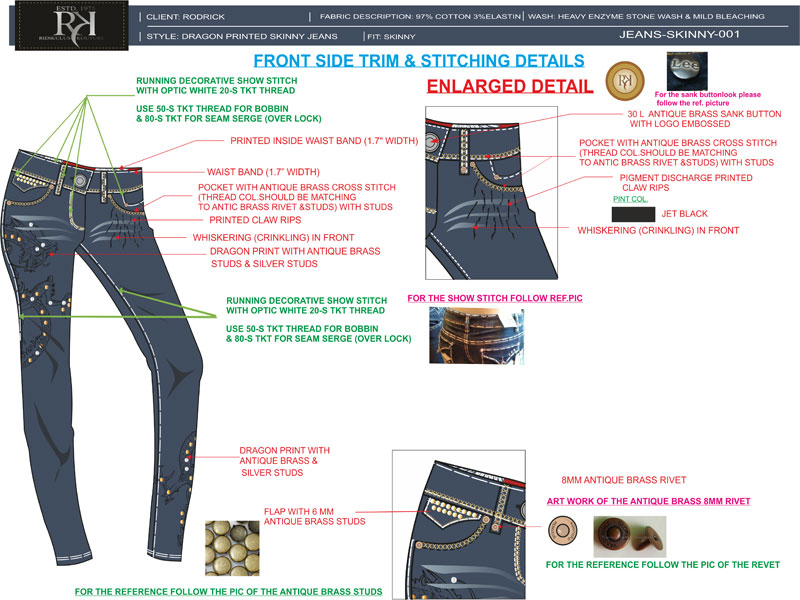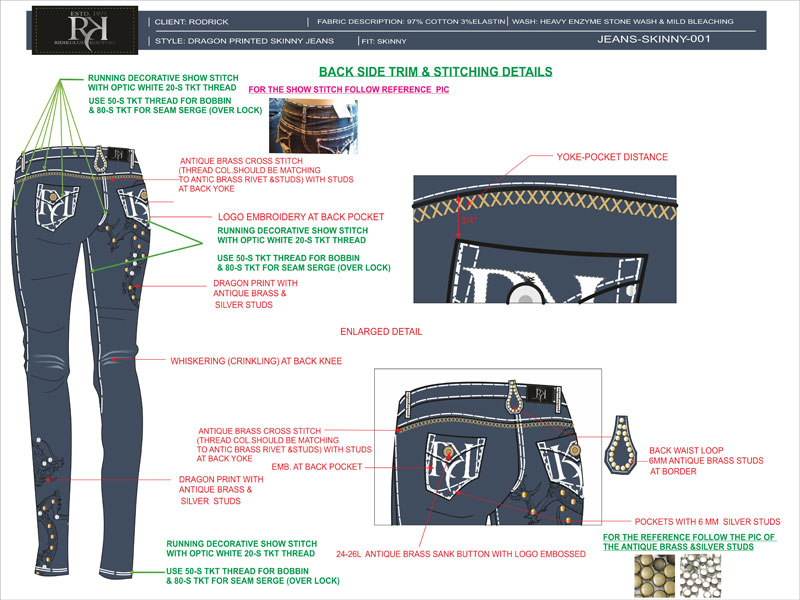Stitching and construction details are foundational pillars of the fashion industry. It is the art of breathing life into garments for elegant drape, shape, and durability. It has a direct link to the quality of your garment. This has a direct impact on your sales and customer satisfaction. However, start-ups do not realize the importance of this and tend to ignore it and leave it to vendors. Fashion startups ignore stitching and construction details and focus only on spec sheets. But without this information, a tech pack is never complete. It has critical factors without which apparel design and production instruction are incomplete. Including stitching and construction details in fashion tech packs is the best practice. And quality tech pack designers from the top fashion houses know the importance of this.
Understanding the Specifics of Stitching and Construction Details
Stitching is far more than just connecting two pieces of fabric. It involves a myriad of techniques, each serving a unique purpose. The choice of stitching method can impact the garment’s overall look and functionality, whether basic hand stitches or advanced machine stitches; expertise is required to give a style the desired look. So, understanding the stitching techniques and how to implement them in a tech pack needs a deep study. Here are some techniques manufacturers use in stitching and garment construction detailing.
Hand Stitching
Hand stitching, the oldest method, imparts a unique character to garments with tradition and charm. Artisans use various stitch techniques for intricate patterns and secure seams with precision. Some of the traditional stitching techniques are running backstitch and whipstitch. Although the oldest, couture boutiques use hand stitching for critical garment areas.
Machine Stitching
Technological advancements have made machine stitching the backbone of mass garment production. Machine stitching has given the wings to garment manufacturing and mass production. Industrial machines have played a key role in speed and precision. Zigzag, lockstitch, and overlock are versatile examples of machine stitching techniques. Sewing machines employ these techniques to create durable and polished seams in garment construction.
Types of Industrial Stitching Machines and Their Applications
In garment manufacturing, precision and efficiency are paramount in a competitive environment. Behind the scenes, various industrial stitching machines play a pivotal role. Those machines are vital in transforming raw fabric into finely crafted garments. Some of the industrial stitching machines and their applications are explained below.
Single-Needle Lockstitch Machine
Single-needle or lock stitch machines are standard and widely used in garment units. They are considered workhorses because they create a secure and straight stitch ideal for seams, hems, and basic garment construction.
Overlock Machine
Overlock machines, also known as sergers, are indispensable for finishing fabric edges. This machine trims excess seam allowance while stitching, preventing fraying and giving the garment a neat and professional look. Overlock machines are widely used in knitwear and lingerie production. Two varieties of overlock machines, such as 4-thread and 5-thread overlock machines, are used in exports.
Chainstitch Machine
The chain stitch machine creates a linked series of stitches, forming a distinctive chain-like pattern. This machine is used for decorative stitching, attaching waistbands, and sewing buttonholes efficiently. It looks like a single-needle machine with some added parts. Chain stitches are more flexible than lock stitches. You can find the application of a chain stitch machine in jeans’ waistbands and leg seams.
Coverstitch Machine
Coverstitch Machines are used to give bottom hems a professional look. They produce a double or triple line of stitch on the top side of the fabric and serge the edge of the bottom. In common language, it is also called a bottom hem double needle machine. They are widely used in the production of Activewear and knitted jersey garments.
Buttonhole Machine
As the name suggests, the buttonhole machine automates creating buttonholes. In general terms, it is also known as the Kaza button machine. Factories that produce button-down shirts or any garment with button enclosures use it. It ensures precision and uniformity in making button holes and stitching buttons. It is crucial for producing shirts and other garments with button enclosures.
Bar Tack Machine
Bar tack machines specialize in reinforcing specific points on a garment, such as pocket corners or belt loops. This is a small operation in stitching and garment construction, but it is crucial. They create short, dense stitches that add strength and durability to key areas of the garment.
Flatlock Machine
The Flatlock machine creates flat seams, primarily in sportswear and undergarments. This produces a flat seam by overlapping the edge of the fabric. This results in a comfortable and chafe-free finish in garments. There are two varieties of flat lock machines. One is regular flat lock machines that are used for plain surface stitching. The other one is a cylinder bed flat lock machine. Cylinder bed flat lock machines join the Waistband with the central part of the garment. An example of this is attaching the waistband elastic to the body part of an undergarment.
Stitching and Garment Construction Details
Garment construction involves assembling individual pieces into a cohesive whole, and the devil is truly in the details. Here are some key elements that contribute to a garment’s overall construction.
Seam Finishes
The seam finish of a garment reflects its quality and richness. Serging, binding, or flat-fell seams enhance durability and contribute to a polished appearance. Garments with good seam finishes are considered quality garments and are priced better than those without.
Darts and Pleats
These are essential elements in shaping garments to fit the body’s contours. Darts are tailored to strengthen the waist part of the garment, and pleats add volume to the garment. Those are crucial details for achieving the desired silhouette shape.
Zippers and Closures
Manufacturers use zippers, buttons, and snaps to enhance the functionality of garments. Closures affect the functionality of a garment and contribute to its aesthetic appeal. The choice of closures ultimately depends on the design and pattern. In some cases, they are necessary, and in some, they are part of embellishment. Well-placed closures ensure a garment fits snugly and is easy to put on and remove.
Hemming
The finishing touch to any garment, hemming provides a clean and polished edge. Blind hemming and topstitching techniques add a professional touch. This enhances the overall visual appeal of a garment.
Crucial Role of Garment Stitching and Construction Details in a Tech Pack
A tech pack is a blueprint for efficiently transforming creative designs into tangible garments. Stitching and construction details are an essential part of a garment tech pack. This comprehensive document holds the key to seamless communication among designers and manufacturers. Garment stitching and construction details are crucial to the tech pack’s importance. Let’s highlight how those elements are critical for achieving precision and how they ensure a successful garment manufacturing process. Remember, the accuracy of this detail depends on the tech pack designer’s experience.
Clarity in Design Intent
A tech pack is a visual and informational guide for translating design concepts into actual garments. Detailed stitching specifications and construction details ensure clear communication of intended design elements. This clarity helps avoid misunderstandings or misinterpretations during the production phase.
Ensuring Consistency Across Prototypes
It is important to mention garment stitching details, seam types, stitch lengths, and thread specifications. Those specifications play a pivotal role in maintaining consistency across garment prototypes. A well-defined tech pack ensures that each sample aligns with the designer’s vision, helping create a cohesive collection.
Facilitating Efficient Communication
Clear and precise construction details within a tech pack streamline communication. The process flow is clear for both designers and manufacturers. A comprehensive guide minimizes errors, reduces communication, and accelerates the production timeline—a win-win situation for everyone involved.
Quality Assurance
Garment stitching and construction details in a fashion technical sheet act as quality control checkpoints. Tech pack designers set quality standards by specifying stitching details and construction methods. This proactive approach helps identify and address potential issues before they escalate.
Cost and Time Efficiency
A well-detailed tech pack can contribute to cost and time efficiency in manufacturing. Precise stitching and construction details allow manufacturers to do proper costing. This also helps anticipate an accurate production timeline. This foresight helps prevent unexpected delays and cost overruns.
Empowering Collaboration
Effective communication between designers, pattern makers, and production teams is crucial. Stitching and construction details serve as a common language, fostering collaboration. This helps create an efficient workflow between departments in the fashion industry.
The modern dynamic apparel industry demands mastering the art of stitching and construction details. It needs the collaboration of meticulous, skilled artisans and the precision of cutting-edge machines. This fusion of craftsmanship and innovation celebrates beauty in stitching and construction details. The world of industrial stitching machines is diverse. Each specializes and serves a unique purpose in the process of apparel production. Each ensures precision and efficiency in output from single-needle lockstitch to buttonhole machines. Tech packs serve as instructors in this complex garment manufacturing process. And the designer preparing tech packs has to be top-notch in her field. Recognizing details in a tech pack, the industry harmonizes creativity and precision, realizing the designer’s vision.

